Low-Cycle Fatigue Behavior and the Combined Cyclic Hardening Material Model of Plate-Shaped Zn-22Al Alloy for Seismic Dampers
Abstract
:1. Introduction
2. Preparation of the Zn-22Al Alloy
2.1. Casting of the Zn-22Al Alloy Ingots
2.2. Hot Rolling of the Zn-22Al Alloy Plates
2.3. Heat Treatment of the Zn-22Al Alloy Plates
3. Material Test of the Zn-22Al Alloy
3.1. Test Arrangements and Design
3.2. Monotonic Tensile Tests
3.3. Low-Cycle Fatigue Tests
3.3.1. Cyclic Stress–Strain Curves
3.3.2. Strain–Life Relationship
3.4. Energy Dissipation
4. Microstructures of the Zn-22Al Alloy
5. Parameter Calibration and Finite Element Simulation
6. Conclusions
- Due to the unavailability of commercially produced Zn-22Al alloy, the alloy used in this study was lab-synthesized. The fracture surface of the as-cast sample displayed brittle failure characteristics with extremely low elongation. In contrast, the fully treated alloy exhibited significantly improved elongation, with the fracture morphology indicating a distinct trend of plastic deformation. SEM micrographs supported these findings by showcasing grain refinement, reinforcing the superplasticity of the treated Zn-22Al alloy.
- Monotonic tests revealed that the Zn-22Al alloy demonstrated continuous yielding behavior and exceptional plastic deformation capability. The alloy’s percentage elongation at fracture reached an impressive 200.37%, corresponding to a fracture strain of 1.12. With an equivalent yield strength of only 40 MPa, the alloy displayed prolonged steady-state flow after yielding until fracture. These properties allow dampers made from Zn-22Al alloy to enter the working state earlier and possess a considerable reserve of plastic deformation capability.
- The Zn-22Al alloy exhibited full and symmetrical hysteresis loops, showcasing subtle strain softening under cyclic loading, with stabilization occurring within the initial cycles. Despite challenges posed by its plate-shaped geometry, the alloy displayed an excellent fatigue life—2.25 to 6.07 times that of E250A mild steel (cylindrical specimens). The Ramberg-Osgood model parameters were derived to describe the cyclic stress–strain curve, and the cyclic strain-life relationships aligned well with the conventional Basquin-Coffin-Manson relationship.
- The alloy demonstrated both kinematic and isotropic hardening characteristics under cyclic loading. The parameters of the combined cyclic hardening material model were calibrated, and two sets of kinematic hardening components were superposed to improve simulation accuracy. These parameters were validated to accurately predict the hysteretic behavior of the material using ABAQUS. In practical applications, engineers can select suitable calibrated parameters based on the expected working strain range or consider average values directly.
Author Contributions
Funding
Institutional Review Board Statement
Informed Consent Statement
Data Availability Statement
Conflicts of Interest
References
- Kishiki, S.; Zheng, H.; Ishida, T.; Tatsumi, N.; Watanabe, A. Inspection of U-shaped steel dampers based on residual plastic deformation. Eng. Struct. 2021, 245, 112915. [Google Scholar] [CrossRef]
- Tea, Y.S.; Tagawa, H.; Chen, X. Seesaw-arm energy dissipation system with U-shaped steel dampers. Structures 2023, 57, 105143. [Google Scholar] [CrossRef]
- Khoshkalam, M.; Mortezagholi, M.H.; Zahrai, S.M. Proposed modification for ADAS damper to eliminate axial force and improve seismic performance. J. Earthq. Eng. 2022, 26, 5130–5152. [Google Scholar] [CrossRef]
- TahamouliRoudsari, M.; Eslamimanesh, M.; Entezari, A.; Noori, O.; Torkaman, M. Experimental assessment of retrofitting RC moment resisting frames with ADAS and TADAS yielding dampers. Structures 2018, 14, 75–87. [Google Scholar] [CrossRef]
- Bai, J.; Chen, H.; Zhao, J.; Liu, M.; Jin, S. Seismic design and subassemblage tests of buckling-restrained braced RC frames with shear connector gusset connections. Eng. Struct. 2021, 234, 112018. [Google Scholar] [CrossRef]
- Cao, X.-Y.; Feng, D.-C.; Wang, Z.; Wu, G. Parametric investigation of the assembled bolt-connected buckling-restrained brace and performance evaluation of its application into structural retrofit. J. Build. Eng. 2022, 48, 103988. [Google Scholar] [CrossRef]
- Kalpakidis, I.V.; Constantinou, M.C.; Whittaker, A.S. Modeling strength degradation in lead–rubber bearings under earthquake shaking. Earthq. Eng. Struct. Dyn. 2010, 39, 1533–1549. [Google Scholar] [CrossRef]
- Xu, L.Y.; Nie, X.; Fan, J.S.; Liu, F.J.; Li, S.Y.; Huang, Z.H. Experimental investigation of low-yield-point steel shear panel dampers. J. Tsing. Univ. 2016, 56, 991–996. [Google Scholar] [CrossRef]
- Zirakian, T.; Zhang, J. Seismic design and behavior of low yield point steel plate shear walls. Int. J. Steel Struct. 2015, 15, 135–151. [Google Scholar] [CrossRef]
- Takagi, T.; Minami, T.; Kushibe, A.; Takigawa, Y.; Higashi, K. Development of room temperature superplastic Zn-Al alloy and application for seismic damper. Mater. Jpn. 2009, 48, 88–90. [Google Scholar] [CrossRef]
- Koichi, M.; Yuichi, M.; Hiroki, U.; Toru, O. Zinc-Aluminum Alloy for Earthquake Damping and Its Production. J.P. Patent JPH11222643A, 6 February 1998. [Google Scholar]
- Tanaka, T.; Kushibe, A.; Kohzu, M.; Takigawa, Y.; Higashi, K. Low-cycle fatigue properties of ultrafine-grained zinc–22wt.% aluminum alloy during room-temperature superplastic flow. Scr. Mater. 2008, 59, 215–218. [Google Scholar] [CrossRef]
- Curadelli, R.; Riera, J.D. Design and testing of a lead damper for seismic applications. Proc. Inst. Mech. Eng. Part C J. Mech. Eng. Sci. 2007, 221, 159–164. [Google Scholar] [CrossRef]
- Q3D Elemental Impurities Guidance for Industry; United States Department of Health and Human Services: Washington, DC, USA, 2015.
- Rudolph, C.D. Rudolph’s Pediatrics; Appleton & Lange: Norwalk, CT, USA, 2003. [Google Scholar]
- Zhang, X. Study on composition design and damping performance of Zinc-Aluminum damping alloy. Master’s Dissertation, Fuzhou University, Fuzhou, China, 2017. [Google Scholar]
- Makii, K.; Furuta, S.; Aoki, K.; Kushibe, A.; Tanaka, T.; Higashi, K. A nano-crystalline Zn-Al alloy with high speed superplasticity at room temperature and the application for seismic damper. Mater. Sci. Forum 2004, 447, 497–504. [Google Scholar] [CrossRef]
- Demirtas, M.; Purcek, G.; Yanar, H.; Zhang, Z. Effect of different processes on lamellar-free ultrafine grain formation, room temperature superplasticity and fracture mode of Zn–22Al alloy. J. Alloys Compd. 2016, 663, 775–783. [Google Scholar] [CrossRef]
- Sun, J. An Investigation of Preparation and Mechanical Properties of Room-Temperature Superplastic Zn-22wt.% Al Alloy. Master’s Dissertation, Nanjing University of Science & Technology, Nanjing, China, 2010. [Google Scholar]
- Demirtas, M.; Purcek, G. Room temperature superplaticity in fine/ultrafine grained materials subjected to severe plastic deformation. Mater. Trans. 2019, 60, 1159–1167. [Google Scholar] [CrossRef]
- Yi, Y.; Komine, H.; Furushima, T. Effect of forming conditions on microstructure and room-temperature mechanical characterization of Zn–22Al superplastic microtubes fabricated by direct extrusion. Mater. Sci. Eng. A 2022, 844, 143160. [Google Scholar] [CrossRef]
- Tanaka, T.; Kohzu, M.; Takigawa, Y.; Higashi, K. Low cycle fatigue behavior of Zn–22mass% Al alloy exhibiting high-strain-rate superplasticity at room temperature. Scr. Mater. 2005, 52, 231–236. [Google Scholar] [CrossRef]
- Yoshiaki, G.; Kenmasa, E.; Wada, H. Self-centering composite metal damper consisting of super-elastic and super-plastic metals. Struct. Eng. Pap. Collect. A 2013, 59, 540. [Google Scholar] [CrossRef]
- Fang, C.; Wang, W.; Ji, Y.; Yam, M.C. Superior low-cycle fatigue performance of iron-based SMA for seismic damping application. J. Constr. Steel Res. 2021, 184, 106817. [Google Scholar] [CrossRef]
- Kobe Steel Ltd. Kobe Steel, Takenaka Develop Vibration Dampers Using New Zinc-Aluminum Alloy. 22 February 2001. Available online: https://www.kobelco.co.jp/column/topics-e/messages/85.html (accessed on 17 January 2024).
- Tanaka, T.; Makii, K.; Ueda, H.; Kushibe, A.; Kohzu, M.; Higashi, K. Study on practical application of a new seismic damper using a Zn–Al alloy with a nanocrystalline microstructure. Int. J. Mech. Sci. 2003, 45, 1599–1612. [Google Scholar] [CrossRef]
- Kurosawa, T.; Otani, T.; Hoshino, K. Damping capacity of hypo-eutectic Zn-Al alloys. J. Phys. IV 1996, 6, C8-309–C8-312. [Google Scholar] [CrossRef]
- Dong, X.H.; Cao, Q.D.; Ma, S.J.; Han, S.H.; Tang, W.; Zhang, X.P. Effects of hot rolling on low-cycle fatigue properties of Zn-22 wt.% Al alloy at room temperature. J. Mater. Eng. Perform. 2016, 25, 3822–3829. [Google Scholar] [CrossRef]
- da Costa, E.M.; da Costa, C.E.; Vecchia, F.D.; Rick, C.; Scherer, M.; dos Santos, C.A.; Dedavid, B.A. Study of the influence of copper and magnesium additions on the microstructure formation of Zn–Al hypoeutectic alloys. J. Alloys Compd. 2009, 488, 89–99. [Google Scholar] [CrossRef]
- Hong, Y.; Hu, Y.; Zhao, A. Effects of loading frequency on fatigue behavior of metallic materials—A literature review. Fatigue Fract. Eng. Mater. Struct. 2023, 46, 3077–3098. [Google Scholar] [CrossRef]
- Ahmad, D.; Ajaj, R.M. A multiaxial fracture of ecoflex skin with different shore hardness for morphing wing application. Polymers 2023, 15, 1526. [Google Scholar] [CrossRef]
- Saini, A.; Ahmad, D.; Patra, K. Electromechanical performance analysis of inflated dielectric elastomer membrane for micro pump applications. Electroact. Polym. Actuators Devices 2016, 9798, 979813. [Google Scholar] [CrossRef]
- GB/T 3075-2021; Metallic Materials-Fatigue Testing-Axial Force-Controlled Method. Standards Press of China: Beijing, China, 2021.
- Wen, D.; Song, F.; Li, Z. Application and research on 160MPa low yield point steel for earthquake resistant. J. Iron. Steel. Res. 2010, 22, 52–56. [Google Scholar] [CrossRef]
- Hirata, T.; Tanaka, T.; Chung, S.W.; Takigawa, Y.; Higashi, K. Relationship between deformation behavior and microstructural evolution of friction stir processed Zn–22wt.% Al alloy. Scr. Mater. 2007, 56, 477–480. [Google Scholar] [CrossRef]
- Yang, C.-F.; Pan, J.-H.; Chuang, M.-C. Achieving high strain rate superplasticity via severe plastic deformation processing. J. Mater. Sci. 2008, 43, 6260–6266. [Google Scholar] [CrossRef]
- Tanaka, T.; Higashi, K. Superplasticity at room temperature in Zn-22Al alloy processed by equal-channel-angular extrusion. Mater. Trans. 2004, 45, 1261–1265. [Google Scholar] [CrossRef]
- Demirtas, M.; Yanar, H.; Purcek, G. Optimization of RT superplasticity of UFG Zn-22Al alloy by applying ECAP at different temperatures and phase regions. IOP Conf. Series Mater. Sci. Eng. 2017, 194, 012033. [Google Scholar] [CrossRef]
- Mohamed, F.A.; Ahmed, M.M.I.; Langdon, T.G. Factors influencing ductility in the superplastic Zn-22 Pct Al eutectoid. Met. Trans. A 1977, 8, 933–938. [Google Scholar] [CrossRef]
- Yadav, S.S.; Roy, S.C.; Goyal, S. A comprehensive review and analysis of Masing/non-Masing behavior of materials under fatigue. Fatigue Fract. Eng. Mater. Struct. 2022, 46, 759–783. [Google Scholar] [CrossRef]
- Narendra, P.V.; Prasad, K.; Krishna, E.H.; Kumar, V.; Singh, K.D. Low-Cycle-Fatigue (LCF) behavior and cyclic plasticity modeling of E250A mild steel. Structures 2019, 20, 594–606. [Google Scholar] [CrossRef]
- Zhang, M.; Zhang, H.; Li, M.; Liu, L.; Wang, P. Fatigue behavior and mechanism of dog-bone-shaped specimens of FV520B-I in a very high cycle regime. Fatigue Fract. Eng. Mater. Struct. 2022, 45, 3658–3676. [Google Scholar] [CrossRef]
- Wu, H.; Chi, W.; Xu, W.; Wang, W.; Sun, C. Effects of specimen geometry and surface defect on high and very high cycle fatigue of TC17 alloy. Eng. Fract. Mech. 2022, 276, 108940. [Google Scholar] [CrossRef]
- Shi, G.; Gao, Y.; Wang, X.; Zhang, Y. Low cycle fatigue properties of low yield point steels. China Civil. Eng. J. 2019, 52, 20–26. [Google Scholar] [CrossRef]
- Nip, K.; Gardner, L.; Davies, C.; Elghazouli, A. Extremely low cycle fatigue tests on structural carbon steel and stainless steel. J. Constr. Steel Res. 2010, 66, 96–110. [Google Scholar] [CrossRef]
- Coffin, L.F., Jr. A Study of the Effects of Cyclic Thermal Stresses on a Ductile Metal. Trans. Am. Soc. Mech. Eng. 2022, 76, 931–949. [Google Scholar] [CrossRef]
- Mishra, R.; Valiev, R.; Mukherjee, A. The observation of tensile superplasticity in nanocrystalline materials. Nanostructured Mater. 1997, 9, 473–476. [Google Scholar] [CrossRef]
- Cetin, M.; Demirtas, M.; Sofuoglu, H.; Cora, Ö.; Purcek, G. Effects of grain size on room temperature deformation behavior of Zn–22Al alloy under uniaxial and biaxial loading conditions. Mater. Sci. Eng. A 2016, 672, 78–87. [Google Scholar] [CrossRef]
- Demirtas, M.; Atli, K.C.; Yanar, H.; Purcek, G. Effect of grain refinement and phase composition on room temperature superplasticity and damping capacity of dual-phase Zn–Al alloys. J. Mater. Res. 2018, 33, 1032–1045. [Google Scholar] [CrossRef]
- Lemaitre, J.; Chaboche, J. Mechanics of Solid Materials; Cambridge University Press: Cambridge, UK, 1994. [Google Scholar]
- Wang, Y. Abaqus Analysis User’s Guide; China Machine Press: Beijing, China, 2018. [Google Scholar]
- Yin, F.; Yang, L.; Wang, M.; Zong, L.; Chang, X. Study on ultra-low cycle fatigue behavior of austenitic stainless steel. Thin-Walled Struct. 2019, 143, 106205. [Google Scholar] [CrossRef]

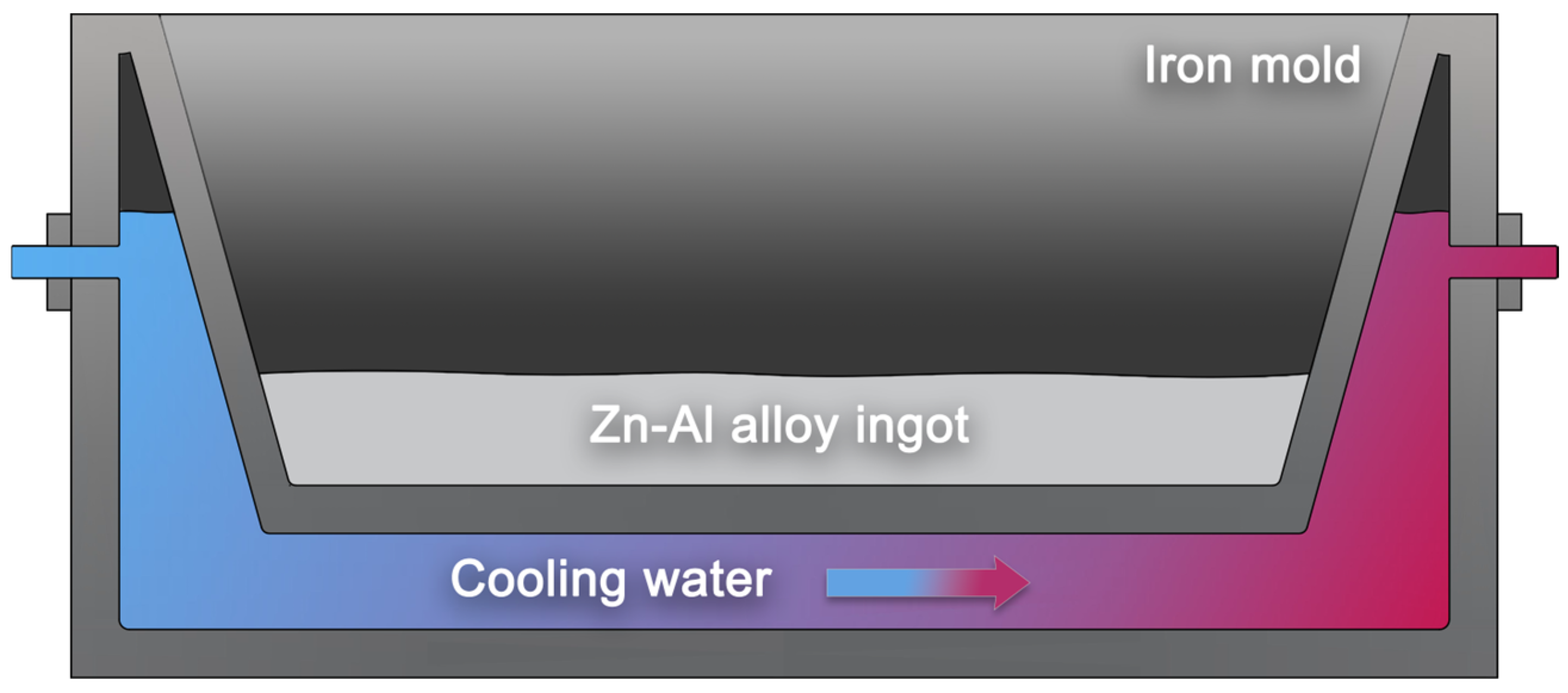

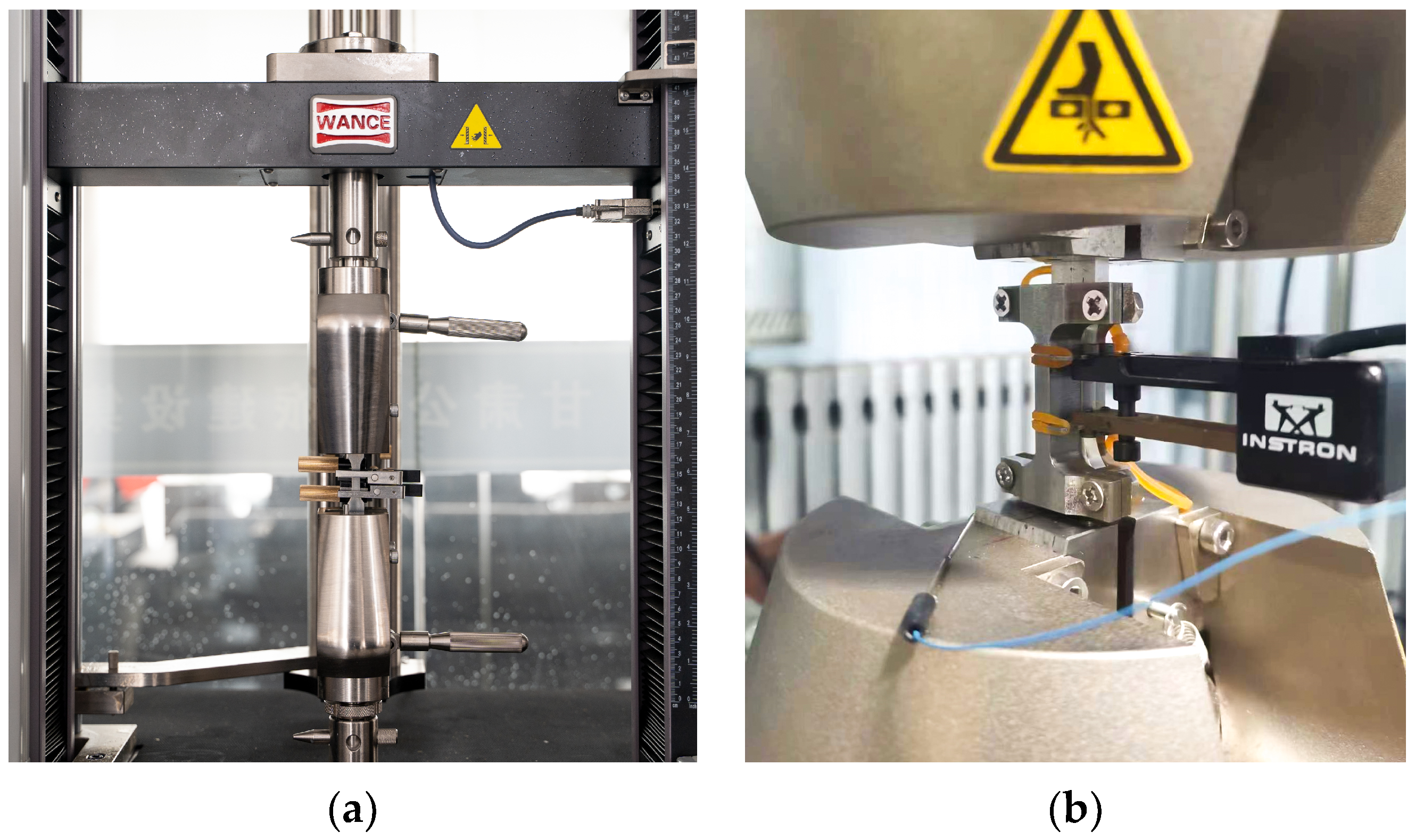

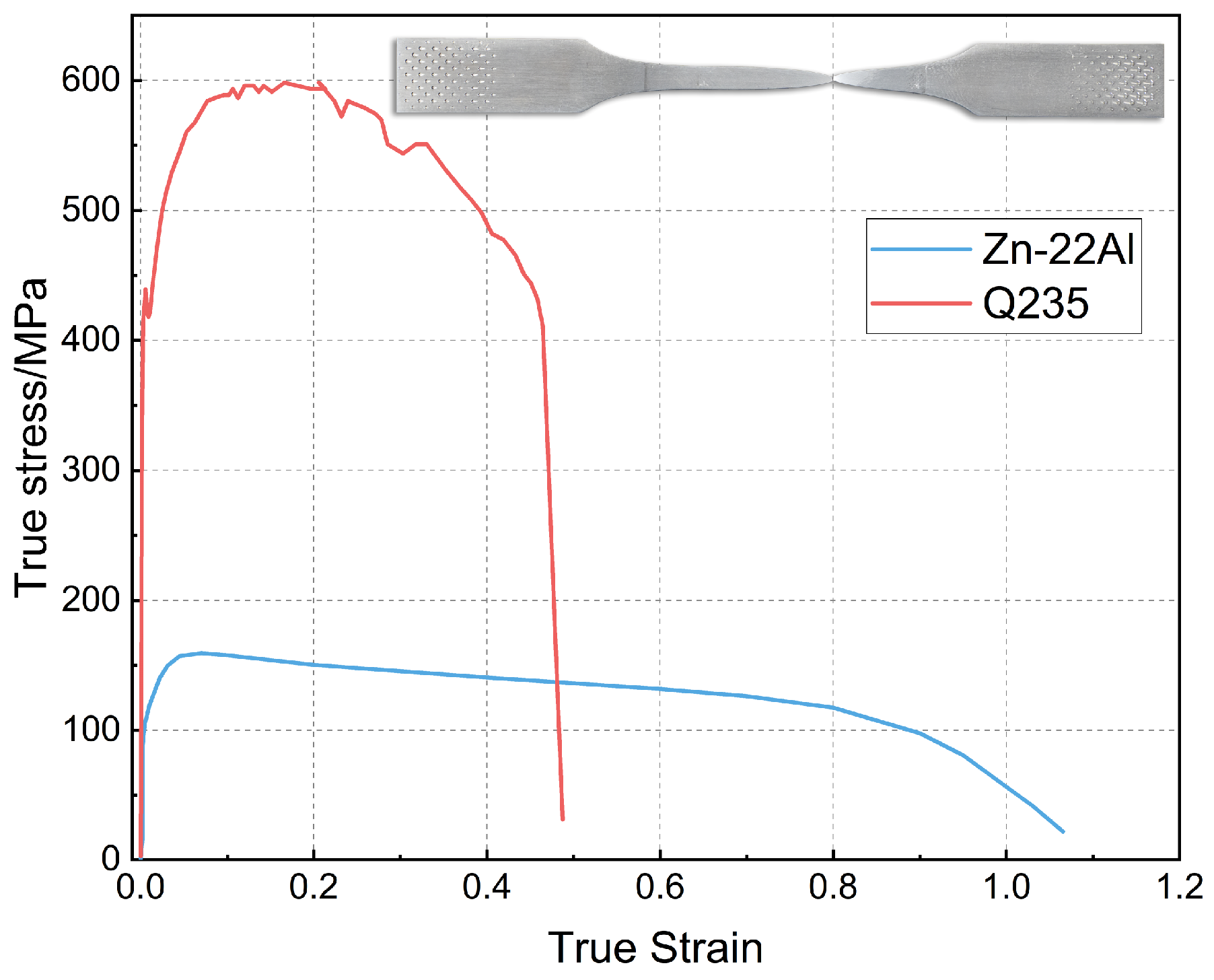
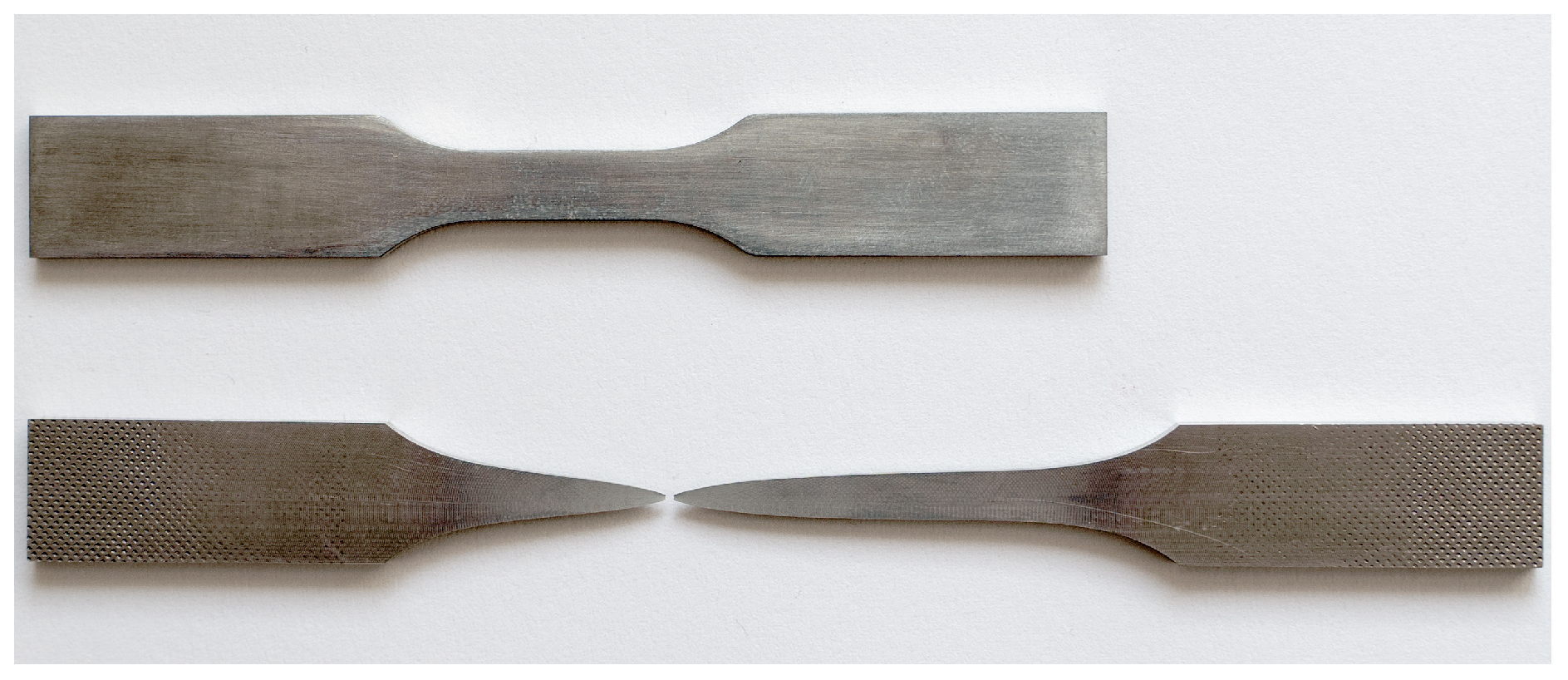

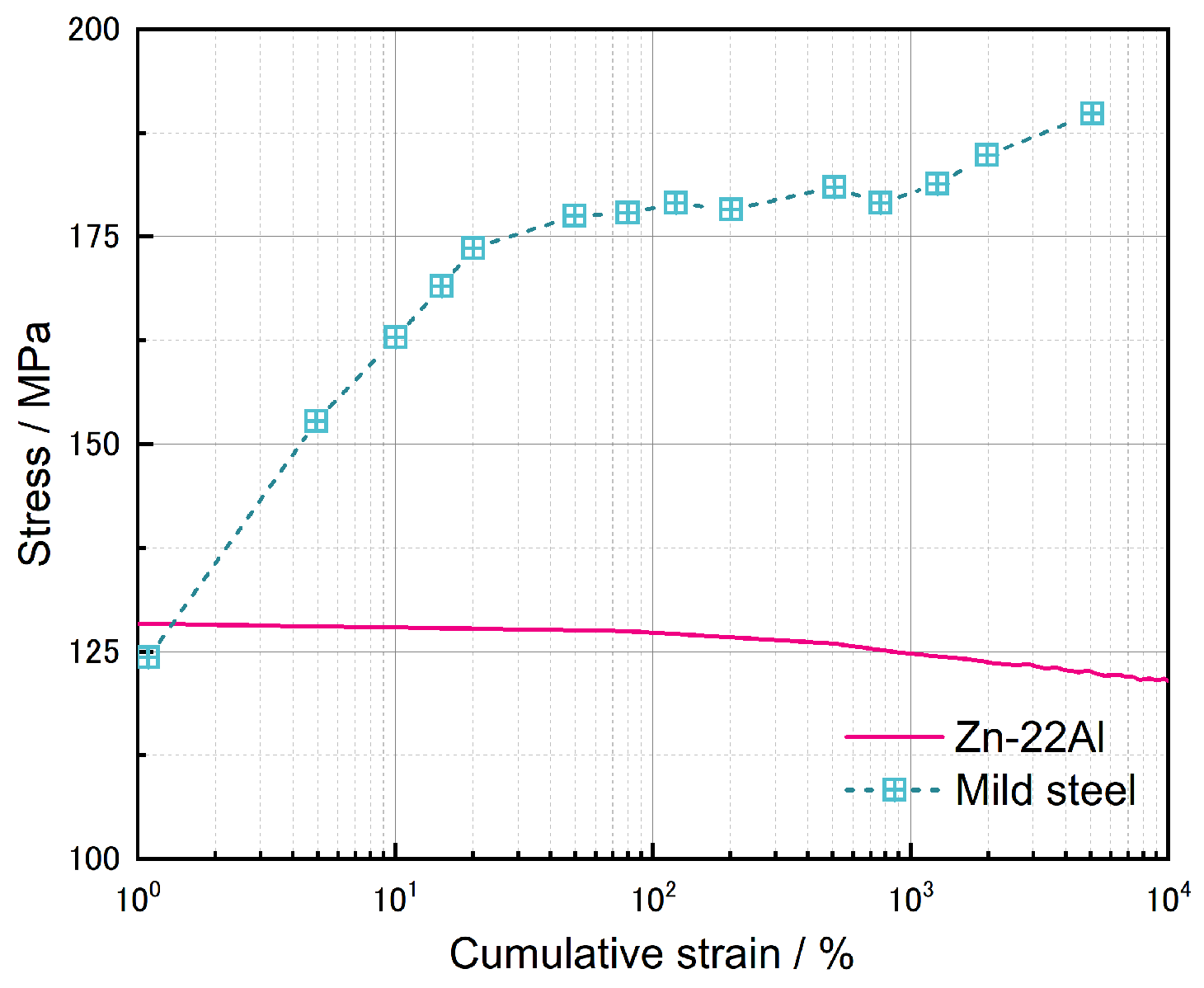

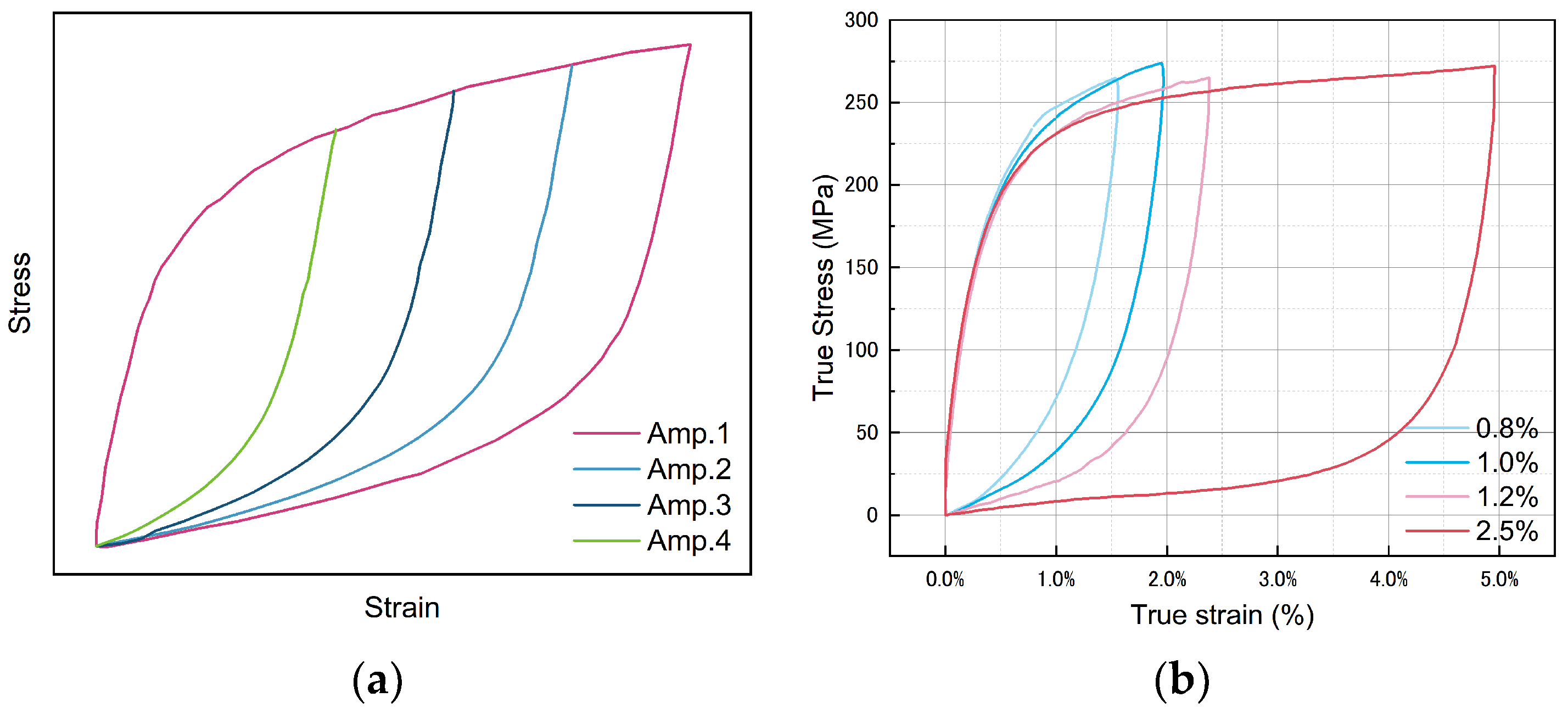
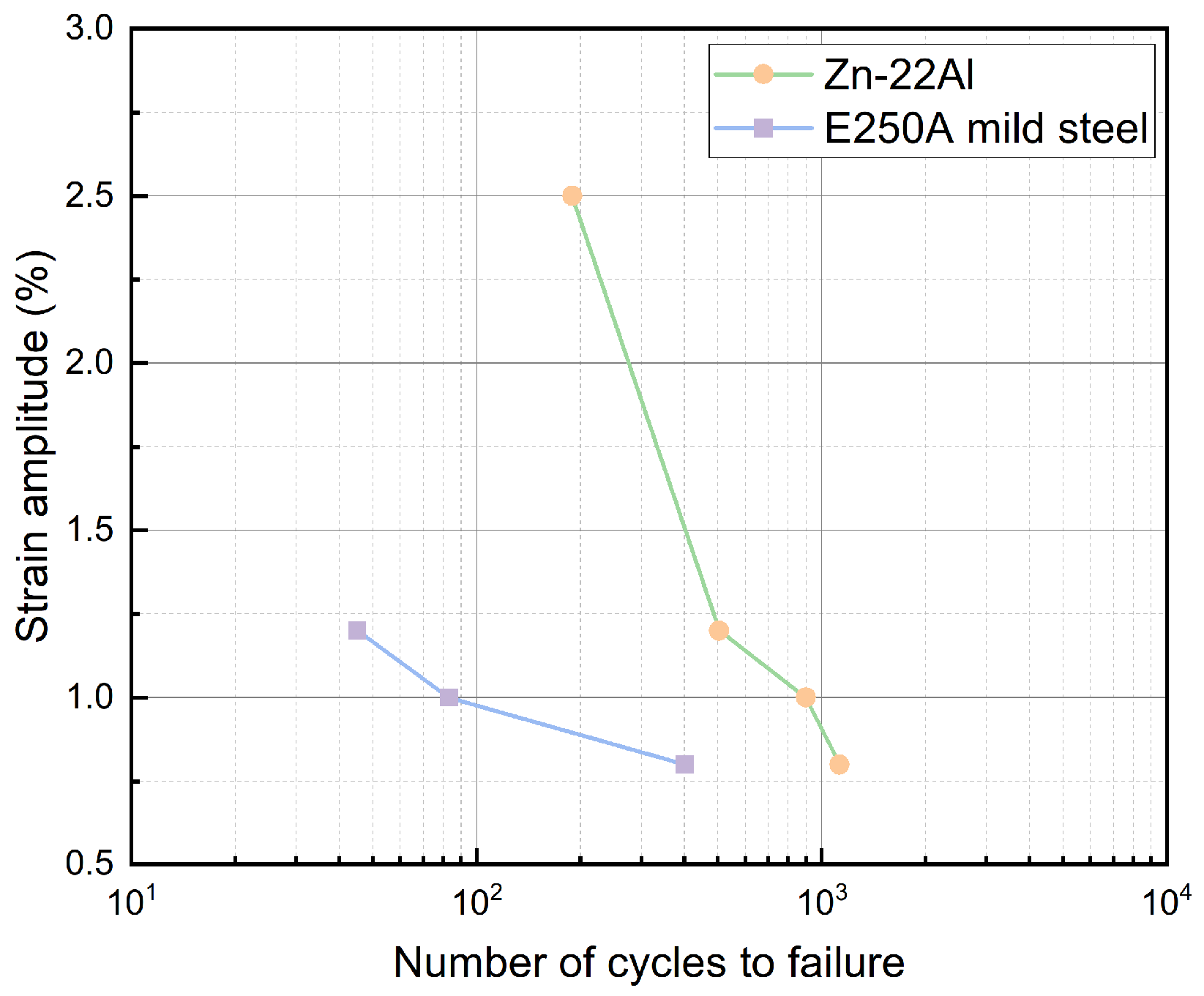
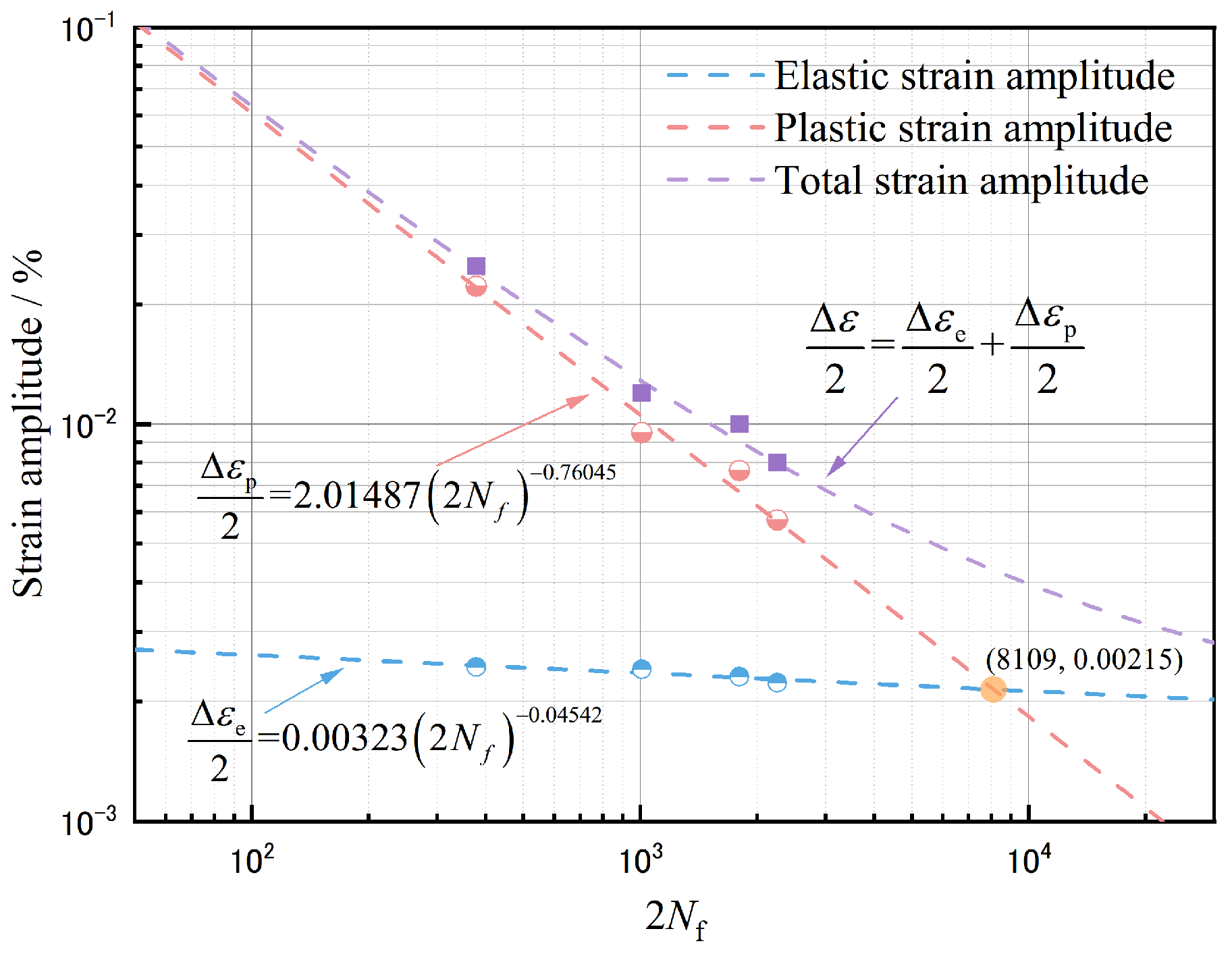
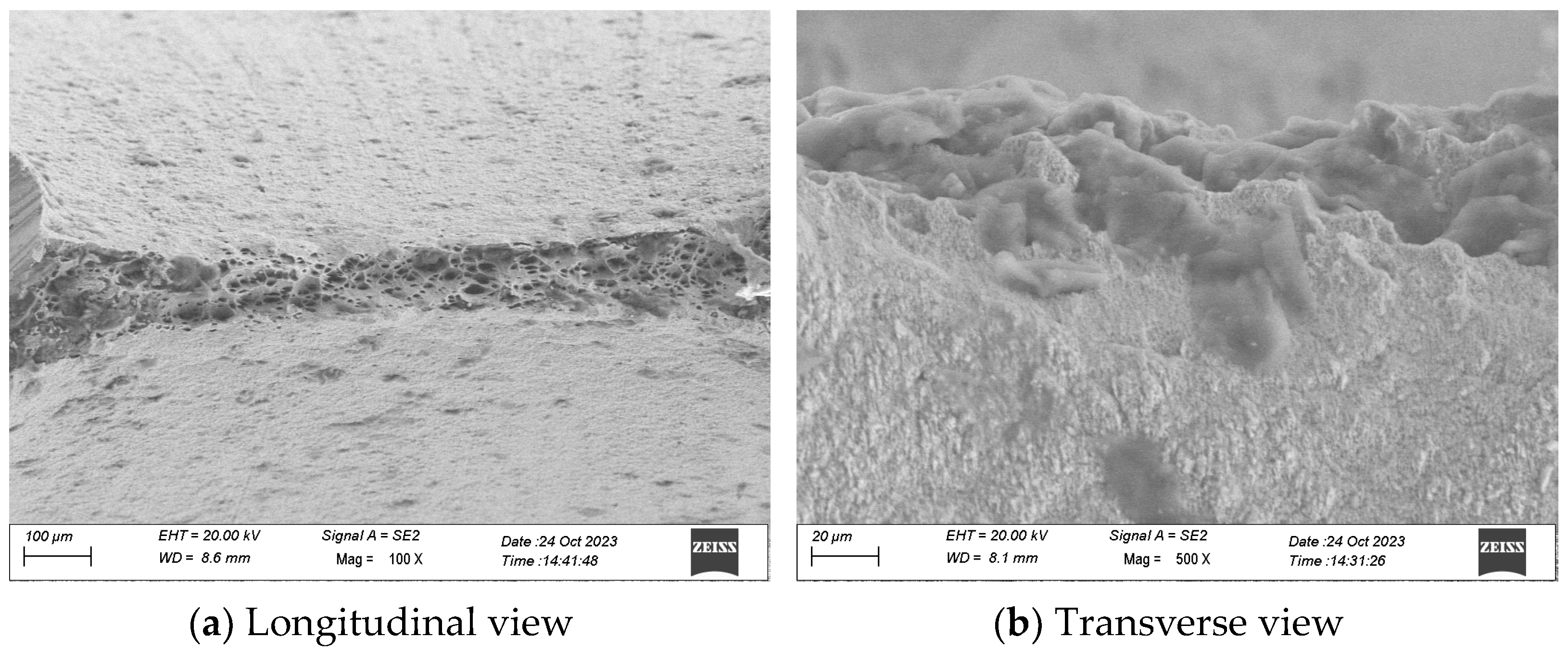
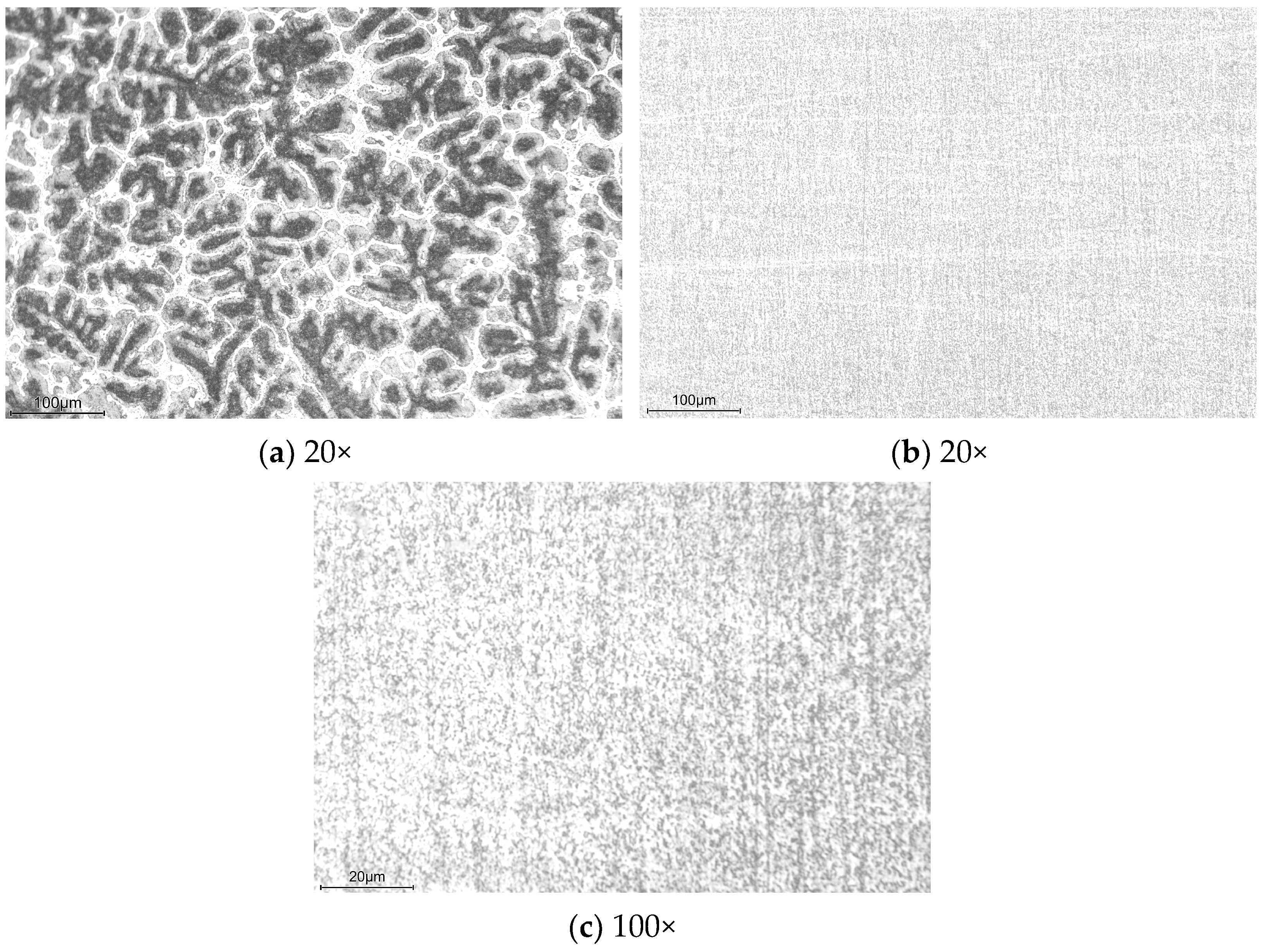

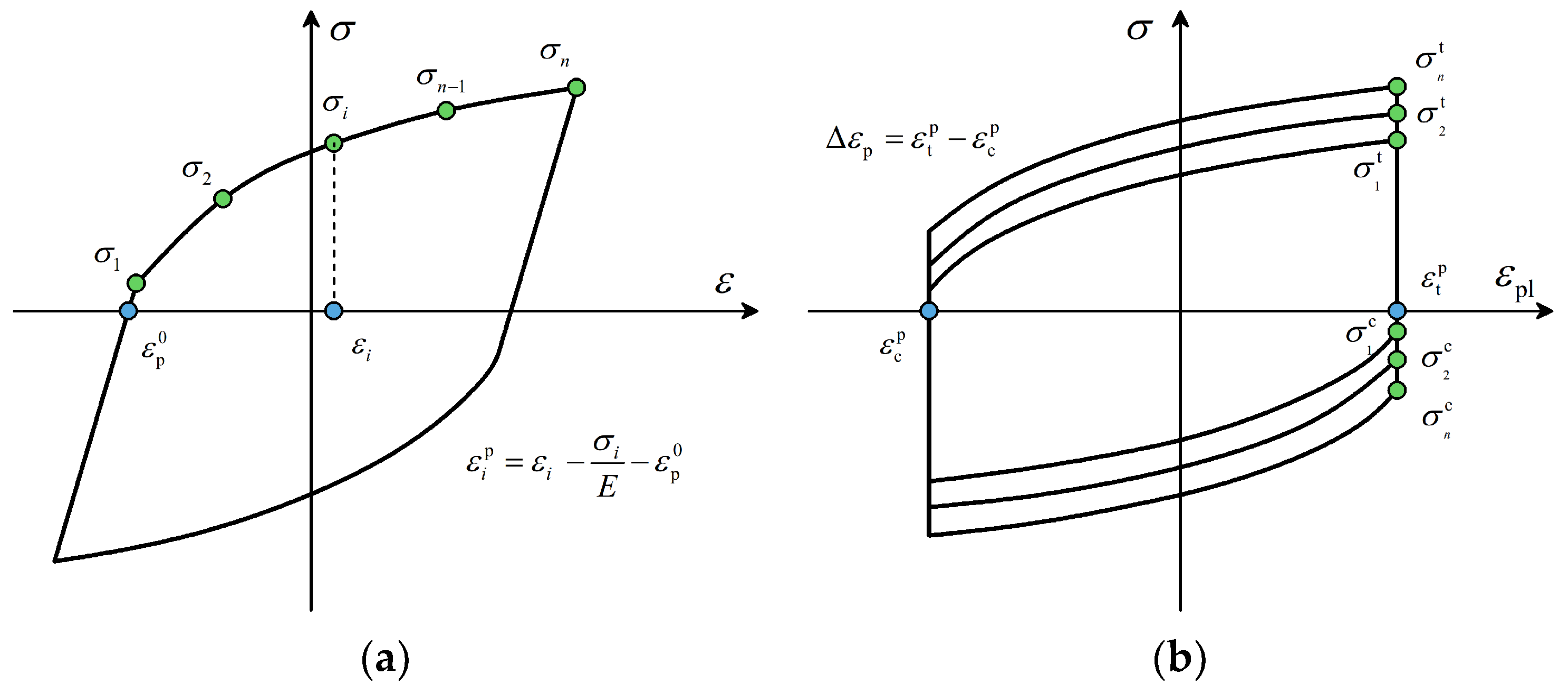
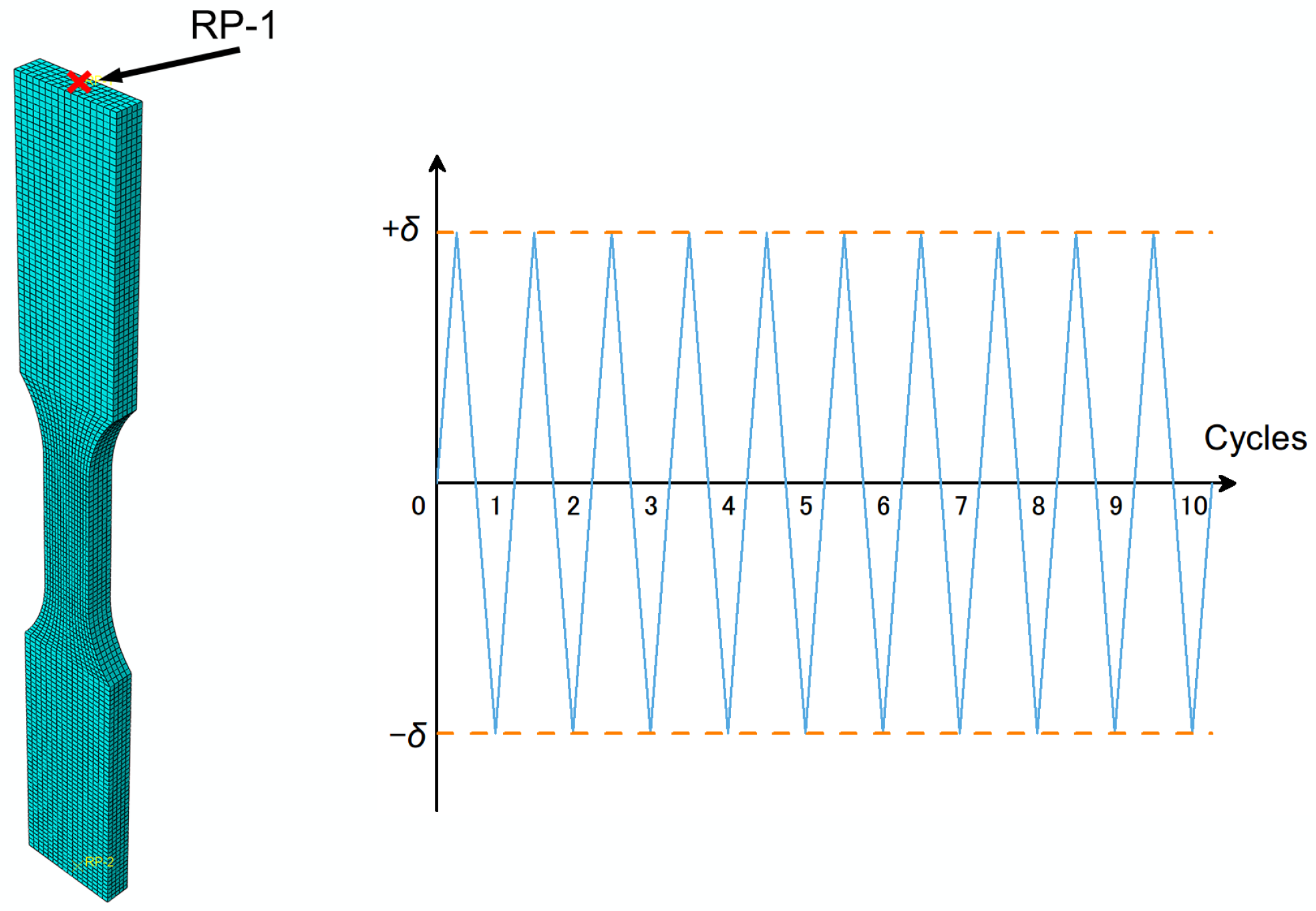
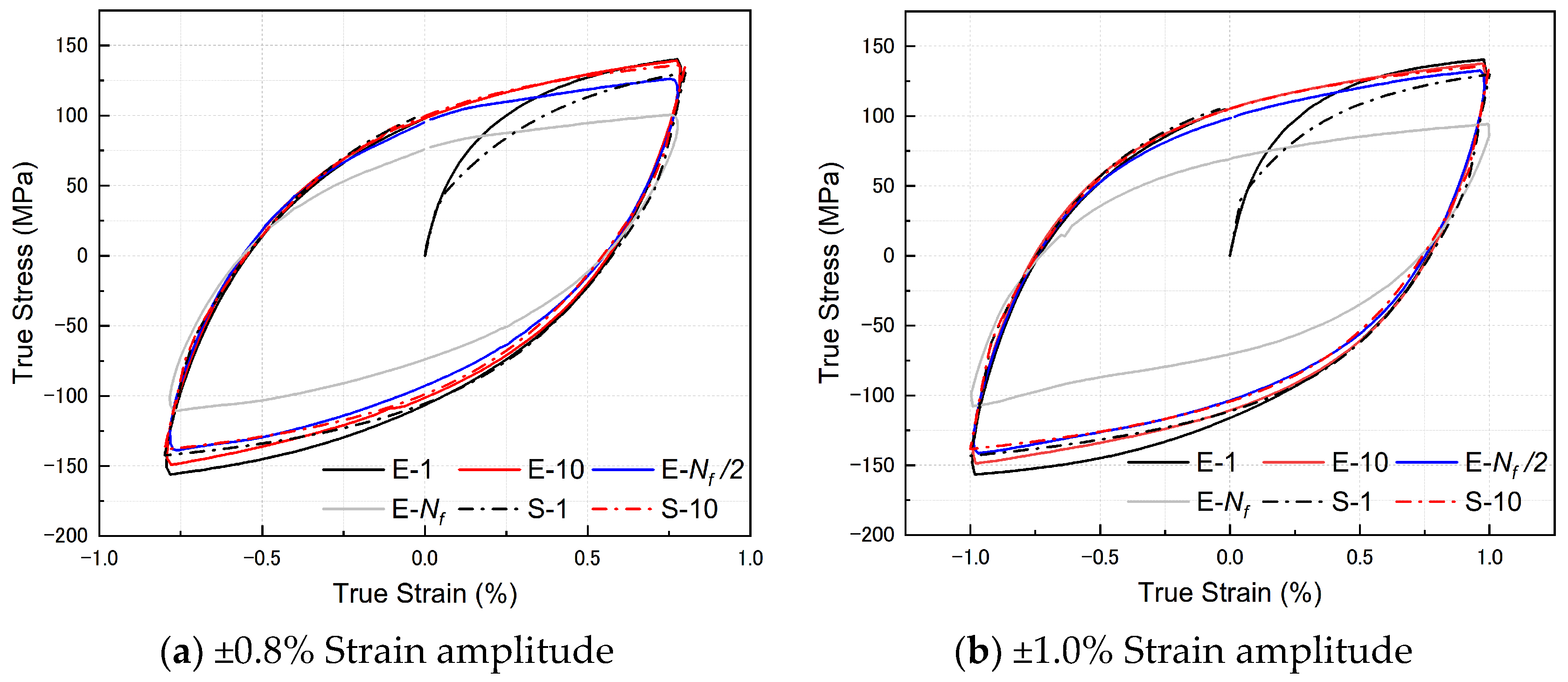

| Identifier | Loading Type | Frequency | Strain Amplitude | Strain Rate |
|---|---|---|---|---|
| Mono-1 | Monotonic | — | Until broken | 2 × 10−3/s |
| Mono-2 | Monotonic | — | Until broken | |
| Mono-3 | Monotonic | — | Until broken | |
| Mono-4 | Monotonic | — | Until broken | |
| Mono-5 | Monotonic | — | Until broken | |
| Cyc-0.8 | Cyclic | 0.0625 Hz | ±0.8% | |
| Cyc-1.0 | Cyclic | 0.05 Hz | ±1.0% | |
| Cyc-1.2 | Cyclic | 0.042 Hz | ±1.2% | |
| Cyc-2.5 | Cyclic | 0.02 Hz | ±2.5% |
| Young’s Modulus E (GPa) | 0.2% Proof Stress (MPa) | Tensile Strength (MPa) | Yield-to-Tensile Ratio | Fracture Elongation (%) | |
|---|---|---|---|---|---|
| Mono-1 | 62 | 43.36 (−0.23%) | 164.28 (+1.74%) | 3.79 (+1.95%) | 215.61 (+7.61%) |
| Mono-2 | 41.72 (−4.00%) | 154.74 (−4.17%) | 3.71 (−0.19%) | 187.79 (−6.28%) | |
| Mono-3 | 42.83 (−1.45%) | 159.67 (−1.12%) | 3.73 (+0.32%) | 213.27 (+6.44%) | |
| Mono-4 | 44.57 (+2.56%) | 163.46 (+1.23%) | 3.67 (−1.31%) | 195.54 (−2.41%) | |
| Mono-5 | 44.81 (+3.11%) | 165.23 (+2.32%) | 3.69 (−0.77%) | 189.63 (−5.36%) | |
| Average | 43.46 | 161.48 | 3.72 | 200.37 |
| Material | Superplastic Properties | Ref. | ||||||
|---|---|---|---|---|---|---|---|---|
| Type | Process | Grain Size (μm) | Shape | T (K) | Yield/Flow Stress (MPa) | Max Elongation (%) | Strain Rate (s−1) | |
| Q235 | — | — | Plate | RT | YS:240 | 35 | 4 × 10−3 | [34] |
| BLY160 | — | — | Plate | RT | YS:126 | 56 | — | [8] |
| Zn-22Al | FSP | 1 | Plate | RT | FS:180 | 160 | 1 × 10−2 | [35] |
| Zn-22Al | ECAP | 0.3 | Cylindrical | RT | FS:150 | 180 | 1 × 10−2 | [36] |
| Zn-22Al | ECAP | 0.35 | Cylindrical | RT | FS:90 | 240 | 1 × 10−2 | [37] |
| Zn-22Al | ECAP | 0.25 | Plate | RT | — | 110 | 1 × 10−3 | [38] |
| Zn-22Al | ECAP | 1 | Plate | RT | — | 195 | 1 × 10−3 | [38] |
| Zn-22Al | TMCP | 2.5 | Plate | 503 | 10.5 | 1557 | 1 × 10−2 | [39] |
| Zn-22Al | TMCP | <0.1 | Plate | RT | YS:200 | 180 | 1 × 10−2 | [26] |
| Zn-22Al | TMCP | 1.3 | Cylindrical | RT | 60 | ~200 | 1 × 10−5 | [39] |
| Zn-22Al | TMCP | — | Plate | RT | 43.46 | 200.37 | 2 × 10−3 | Present work |
| Material | Shape | Strain Amplitude | Ref. | ||||
|---|---|---|---|---|---|---|---|
| ±0.8 | ±1.0 | ±1.2 | ±2.5 | ±3.0 | |||
| Q235 (mild steel) | Cylindrical | — | 578 | — | — | 122 | [24] |
| LY100 | Cylindrical | — | 512~694 | — | 123~126 | 82~119 | [44] |
| LY160 | Cylindrical | — | 1008 | — | 139~158 | 121 | [44] |
| E250A (mild steel) | Cylindrical | 400 | 83 | 45 | — | — | [41] |
| Stainless steel | Plate | — | 671 | — | — | 39 | [45] |
| Zn-22Al (present work) | Plate | 1126 | 899 | 504 | 189 | — | — |
| Δε/2 (%) | σ|0 (MPa) | Q∞ (MPa) | biso | C1 (MPa) | γ1 | C2 (MPa) | γ2 |
|---|---|---|---|---|---|---|---|
| 0.8% | 39.1 | −6.64 | 3.0 | 9000 | 150 | 31,187 | 538 |
| 1.0% | 41.3 | −7.81 | 3.5 | 6480 | 108 | 31,187 | 538 |
| 1.2% | 45.0 | −9.28 | 3.5 | 4680 | 78 | 31,187 | 538 |
| 2.5% | 82.0 | −5.92 | 3.0 | 450 | 3 | 12,475 | 215 |
| Mean | 51.85 | −7.412 | 3.25 | 5152.5 | 84.75 | 26,509 | 457.25 |
| COV | 0.338 | −0.172 | 0.077 | 0.605 | 0.633 | 0.306 | 0.306 |
Disclaimer/Publisher’s Note: The statements, opinions and data contained in all publications are solely those of the individual author(s) and contributor(s) and not of MDPI and/or the editor(s). MDPI and/or the editor(s) disclaim responsibility for any injury to people or property resulting from any ideas, methods, instructions or products referred to in the content. |
© 2024 by the authors. Licensee MDPI, Basel, Switzerland. This article is an open access article distributed under the terms and conditions of the Creative Commons Attribution (CC BY) license (https://creativecommons.org/licenses/by/4.0/).
Share and Cite
Liu, Z.; Han, J.; Yang, P. Low-Cycle Fatigue Behavior and the Combined Cyclic Hardening Material Model of Plate-Shaped Zn-22Al Alloy for Seismic Dampers. Materials 2024, 17, 2141. https://doi.org/10.3390/ma17092141
Liu Z, Han J, Yang P. Low-Cycle Fatigue Behavior and the Combined Cyclic Hardening Material Model of Plate-Shaped Zn-22Al Alloy for Seismic Dampers. Materials. 2024; 17(9):2141. https://doi.org/10.3390/ma17092141
Chicago/Turabian StyleLiu, Zongcheng, Jianping Han, and Penghui Yang. 2024. "Low-Cycle Fatigue Behavior and the Combined Cyclic Hardening Material Model of Plate-Shaped Zn-22Al Alloy for Seismic Dampers" Materials 17, no. 9: 2141. https://doi.org/10.3390/ma17092141





